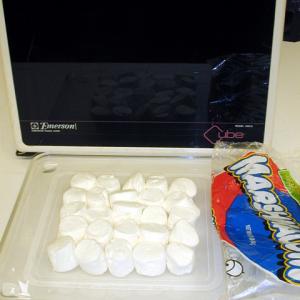College of Liberal Arts & Sciences
6A01.39 - Speed of Light - Microwave
Make an array of marshmallows on the glass plate. Place them in the microwave for a few seconds until some of them begin to melt. Measure the distance between the "hot" spots (antinodes), or the "cold" spots (nodes). This measurement should be the 1/2 wavelength of the microwave ovens free space wavelength. (This should be close to 6.1 cm for the 1/2 wavelength or 12.2 cm for the wavelength of the microwaves from our oven). The frequency of the microwave should be written on the rear of the microwave oven. In our case this is 2450 MHz. With these a calculation of the speed of light should be possible.
For the liquid crystal sheets: Turn the glass tray in the microwave upside down and place the liquid crystal sheet on this. Turn the microwave on for the time specified on each liquid crystal sheet. The antinodes should be readily apparent when the sheets are taken from the microwave. You can use the ruler to measure between the antinodes.
- John E. Beaver, "The Speed of Light with a Short-Wave Radio", TPT, Vol. 38, # 3, March 2000, p. 172.
- Jouni Viiri, "Temperature Distribution in a Microwave Oven", TPT, Vol. 36, # 1, Jan. 1998, p. 48.
- Robert H. Stauffer, Jr. "Finding the Speed of Light with Marshmallows - A Take-Home Lab", TPT, Vol. 35, # 4, April 1997, p. 231.
- C. Swartz, "A Marshmallow Paradox", TPT, Vol. 35, # 6, Sept. 1997, p. 323.
- Fred Bucheit, "Hot Spots in the Morning", TPT, Vol. 32, #4, Apr. 1994, p. 199.
- Barbara S. Andereck, "Microwave Hot Spots",TPT, Vol. 28, # 9, Dec. 1990, p. 580.
- Alistair Steyn-Ross and Alister Riddel, "Standing Waves in a Microwave Oven", TPT, Vol. 28, # 7, Oct. 1990, p. 474.
- Michael C. Schroeder, Charles W. Smith, "Estimating the Speed of Light with a TV Set", TPT, Vol. 23, # 6, Sept. 1985, p. 360.
- L. Bergel, S. Arnold, "Speed of Light Determined by Microwave Interference", AJP, Vol. 44, #6, June 1976, p. 546.
- J. Proud, H. Cronson, H. Huber, "Apparatus for Direct Measurement of the Velocity of Light", AJP, Vol. 37, #9, Sept. 1969, p. 939.
- Cool Threads: Selections from TAP-L 2006, "Measuring the Speed of Light with Marshmallows", PIRA News, Vol. 20, # 1, p. 3, 2007.
- Kerry Parker and Michael Vollmer, "Bad Food and Good Physics: The Development of Domestic Microwave Cookery", Physics Education, Vol. 39, # 1, Jan. 2004, p. 82.
Disclaimer: These demonstrations are provided only for illustrative use by persons affiliated with The University of Iowa and only under the direction of a trained instructor or physicist. The University of Iowa is not responsible for demonstrations performed by those using their own equipment or who choose to use this reference material for their own purpose. The demonstrations included here are within the public domain and can be found in materials contained in libraries, bookstores, and through electronic sources. Performing all or any portion of any of these demonstrations, with or without revisions not depicted here entails inherent risks. These risks include, without limitation, bodily injury (and possibly death), including risks to health that may be temporary or permanent and that may exacerbate a pre-existing medical condition; and property loss or damage. Anyone performing any part of these demonstrations, even with revisions, knowingly and voluntarily assumes all risks associated with them.
